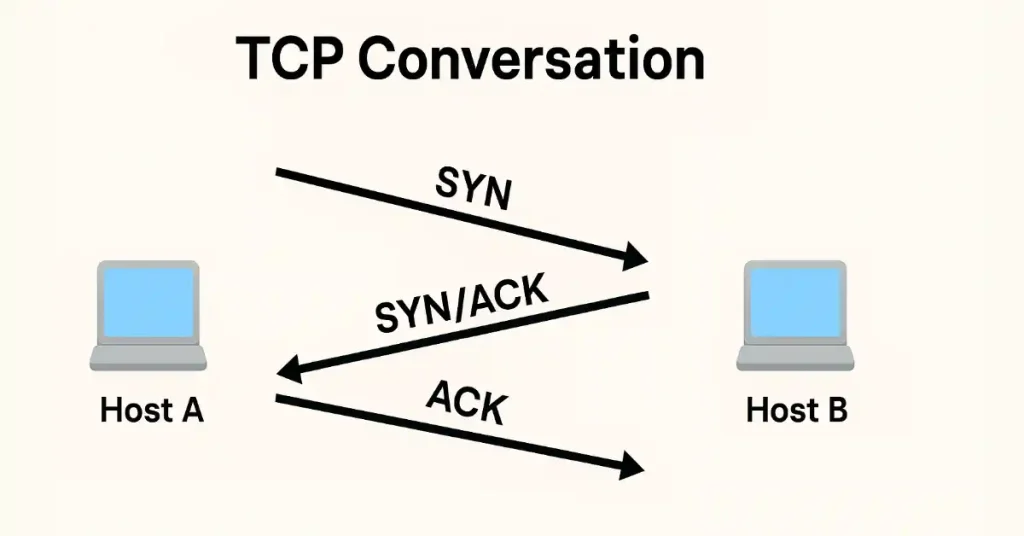In networking, the TCP three-way handshake (often called a “TCP conversation”) establishes reliable connections, which is crucial for Access Control Lists (ACLs) to filter traffic effectively. ACLs manage inbound and outbound traffic based on IP addresses, ports, and TCP flags. This article explains TCP fundamentals before diving into ACL integration, helping CCNA students grasp transport layer basics and CCNP learners apply them to advanced security.
Types of Traffic Control with ACLs
Traffic control via ACLs can be simple or complex:
- Simple (Standard ACLs): Permit or deny based on source IP addresses only (e.g., deny traffic from 192.168.1.0/24).
- Complex (Extended ACLs): Filter based on source/destination IP, protocols, TCP/UDP ports, and flags (e.g., allow HTTP traffic on port 80 from specific hosts).
| ACL Type | Filters On | Example Command (Cisco IOS) |
|---|---|---|
| Standard | Source IP | access-list 10 deny 192.168.1.0 0.0.0.255 |
| Extended | IP, Protocol, Port, Flags | access-list 101 permit tcp any host 10.0.0.1 eq 80 established |
TCP Communication Basics
When a host requests data (e.g., sending an email or downloading a file), IP handles addressing and routing between source and destination. TCP, at the transport layer (OSI Layer 4), ensures reliable delivery by breaking data into segments, numbering them, and reassembling them at the destination.
Think of TCP as a phone call: Hosts “agree” on connection rules before exchanging data, ensuring nothing is lost or duplicated.
How the TCP Three-Way Handshake Works
TCP is connection-oriented, reliable, and full-duplex, with flow and congestion control (e.g., via window sizing and slow-start).
The handshake establishes the connection:
ACK: Client acknowledges server’s SEQ (ACK=301).
SYN: Client sends SYN packet with initial sequence number (e.g., SEQ=100).
SYN-ACK: Server responds with SYN-ACK, acknowledging client’s SEQ (ACK=101) and its own SEQ (e.g., SEQ=300).

TCP Flags and Connection Management
TCP segments use flags:
- SYN: Synchronizes sequence numbers to start a connection.
- ACK: Acknowledges received data.
- FIN: Finishes the connection (graceful close).
- RST: Resets (abrupt close, e.g., errors).
- PSH: Pushes data immediately.
- URG: Indicates urgent data.
Connection termination (four-way handshake):
- Host 1 sends FIN.
- Host 2 sends ACK.
- Host 2 sends FIN.
- Host 1 sends ACK.
This is vital for ACLs, as extended ACLs can match flags (e.g., “established” for ACK or RST set).
TCP Ports and Comparison to UDP
TCP uses ports to direct data to applications (e.g., port 80 for HTTP). Well-known ports (0-1023) include:
- 20/21: FTP
- 25: SMTP
- 80: HTTP
- 443: HTTPS
Port ranges:
- Well-known: 0-1023
- Registered: 1024-49151
- Dynamic/Private: 49152-65535
Unlike TCP, UDP is connectionless and unreliable—great for speed (e.g., DNS on port 53) but not for ACLs needing state tracking.
(Insert Figure 2: Port Range Diagram)
TCP Header Breakdown
The TCP header is 20 bytes minimum (plus options) and includes fields for reliable communication. Here’s a breakdown:
| Field | Size (Bits) | Description |
|---|---|---|
| Source Port | 16 | Identifies the sending application. |
| Destination Port | 16 | Identifies the receiving application. |
| Sequence Number | 32 | Tracks the order of bytes sent. |
| Acknowledgment Number | 32 | Indicates the next expected byte. |
| Data Offset | 4 | Header length in 32-bit words. |
| Reserved | 3 | For future use. |
| Flags (Control Bits) | 9 | SYN, ACK, FIN, etc., for connection control. |
| Window Size | 16 | Flow control: bytes the receiver can accept. |
| Checksum | 16 | Error detection. |
| Urgent Pointer | 16 | Points to urgent data if URG flag is set. |
| Options | Variable | E.g., Maximum Segment Size (MSS). |
Understanding the header is crucial for CCNP-level packet analysis, such as using Wireshark to inspect TCP streams.
Troubleshooting TCP Connections
Common issues include:
- SYN Floods: Attackers send SYN packets without completing the handshake, exhausting server resources. Mitigate with ACLs or SYN cookies.
- Connection Timeouts: Check sequence numbers and acknowledgments using netstat -an or show tcp brief on Cisco devices.
- Port Conflicts: Ensure applications use correct ports; use telnet or nc for testing.
Tools like Wireshark capture TCP handshakes: Filter with tcp.flags.syn == 1 to see initiations.
Conclusion
Mastering TCP conversations and their integration with ACLs is foundational for essential for troubleshooting and security. Practice in Packet Tracer or GNS3 to solidify concepts. For deeper dives, refer to RFC 793 (TCP specification) or Cisco’s official documentation.
FAQs
What is the TCP three-way handshake?
The TCP three-way handshake establishes a reliable connection using three steps: SYN (client synchronizes sequence number), SYN-ACK (server acknowledges and synchronizes), and ACK (client confirms). This ensures both hosts agree on parameters for error-free data transfer, vital for applications like web browsing.
Why is the TCP three-way handshake important?
It prevents data loss by synchronizing sequence numbers and confirming readiness, enabling flow control and ordered delivery. In security, it supports ACLs for stateful filtering (e.g., “established” keyword), protecting against attacks like SYN floods in enterprise networks.
What are the common issues with TCP handshakes?
Issues include SYN floods (overloading servers with unfinished connections), timeouts from mismatched acknowledgments, and port conflicts. Mitigate with ACLs, SYN cookies, or tools like Wireshark for packet analysis and Cisco commands like “show tcp brief” for diagnostics.
How does TCP differ from UDP in connection setup?
TCP uses a three-way handshake for reliable, connection-oriented setup with acknowledgments and retransmissions. UDP is connectionless and faster but unreliable, lacking handshakes—ideal for streaming but unsuitable for ACL state tracking or error-sensitive apps like email.
What TCP flags are used in the three-way handshake?
Key flags: SYN for initialization, ACK for confirmation in SYN-ACK and final ACK. Post-handshake, FIN/RST manage closure. These bits in the TCP header allow precise control, enabling security features like extended ACLs to permit only established sessions.





